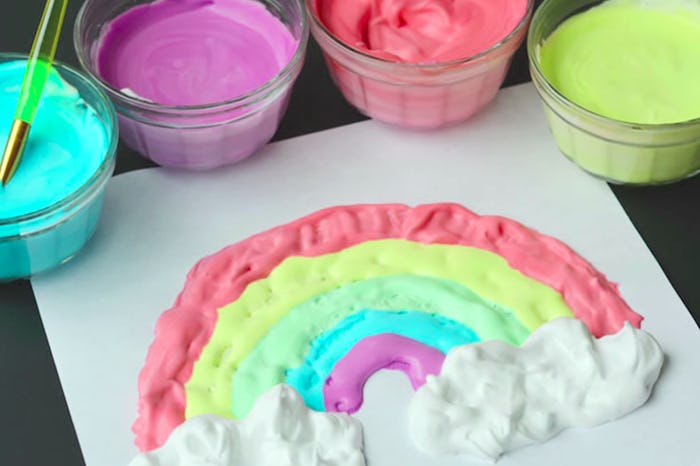Life
What Parents Need To Know Before Whipping Up DIY Puffy Paint
Whether it’s a rainy day or summer break, it can be a real sanity saver to have indoor projects on hand to keep kids busy, and cabin fever at bay. And with the endless number of DIY craft ideas on Pinterest and the like, there is no shortage of options. You can make your own slime, stuffed sock toys, and even scribbles-turned-modern-art, but what about recipes for making puffy paint at home? It looks like fun, but is homemade puffy paint safe?
"I believe that homemade puffy paint is generally safe," says Texas-based Dr. Eboni Hollier, who is board-certified in both general and developmental and behavioral pediatrics, in a Romper email interview. "However, it must be considered that some of the ingredients are not meant to be eaten."
Common ingredients in homemade puffy paint recipes include flour, shaving cream, food coloring, salt, white glue, washable paint, and cornstarch. Parents should be cautious with certain ingredients, like the shaving cream and glue, Hollier says, because they are not edible. "If ingested in small amounts, it is unlikely to cause harm, although minor irritation to the mouth area may result," she says.
When choosing ingredients, Hollier suggests that parents opt for school glue, like Elmer’s, and avoid super glue or similar adhesives, as well as food coloring instead of washable paints. "The food coloring will provide the different colors that will be fun to use in the paints," she says. "But washable paints are not meant to be eaten."
Parents should also test for allergies before using craft products, Dr. Daniel Ganjian, a board-certified pediatrician at Providence Saint John’s Health Center in Santa Monica, California, tells Romper. He advises parents to try a small amount of the paint on the skin and wait one hour to make sure the child doesn't have an allergy to any of the ingredients.
Hollier and Ganjian both advise that if parents are concerned that their child has eaten a toxic level of art supplies, or if they have further questions about the safety of some of these products, they should consider calling the national Poison Control Center at 1-800-222-1222. Ganijan says kids can start using homemade puffy paint at 2 years old or "as soon as they stop putting everything in their mouths repeatedly."
Benefits to children practicing their art skills with something like homemade puffy paint include enhancing fine motor skills, creating experience with cause and effect, and helping to develop hand-eye coordination, Hollier says.
As for avoiding a huge mess, she adds that planning is key. Use poster board, thick construction paper, or paper plates as a buffer between a table and the project in case the paint leaks through. Consider also securing the sides of the painting surface with something like masking tape to prevent the paper from sliding around.
So you may have failed at bunny pancakes and the red, white, and blue 4th of July cake, but it looks like you have a chance to redeem your DIY reputation after all.
